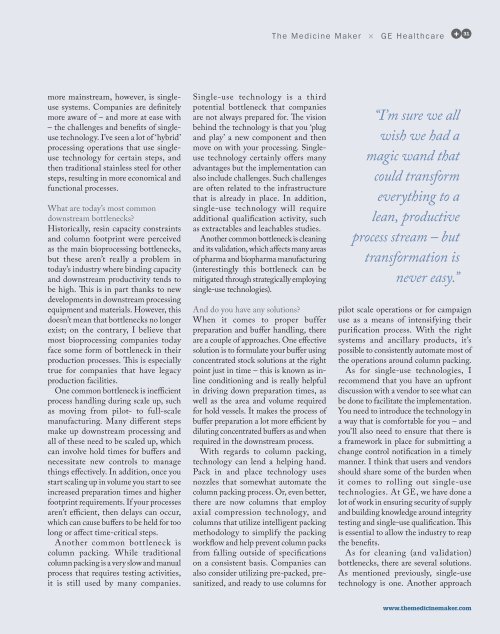Sparks of Inhalation Innovation
TMM_1015
TMM_1015
Create successful ePaper yourself
Turn your PDF publications into a flip-book with our unique Google optimized e-Paper software.
The Medicine Maker × GE Healthcare<br />
31<br />
<br />
more mainstream, however, is singleuse<br />
systems. Companies are definitely<br />
more aware <strong>of</strong> – and more at ease with<br />
– the challenges and benefits <strong>of</strong> singleuse<br />
technology. I’ve seen a lot <strong>of</strong> ‘hybrid’<br />
processing operations that use singleuse<br />
technology for certain steps, and<br />
then traditional stainless steel for other<br />
steps, resulting in more economical and<br />
functional processes.<br />
What are today’s most common<br />
downstream bottlenecks?<br />
Historically, resin capacity constraints<br />
and column footprint were perceived<br />
as the main bioprocessing bottlenecks,<br />
but these aren’t really a problem in<br />
today’s industry where binding capacity<br />
and downstream productivity tends to<br />
be high. This is in part thanks to new<br />
developments in downstream processing<br />
equipment and materials. However, this<br />
doesn’t mean that bottlenecks no longer<br />
exist; on the contrary, I believe that<br />
most bioprocessing companies today<br />
face some form <strong>of</strong> bottleneck in their<br />
production processes. This is especially<br />
true for companies that have legacy<br />
production facilities.<br />
One common bottleneck is inefficient<br />
process handling during scale up, such<br />
as moving from pilot- to full-scale<br />
manufacturing. Many different steps<br />
make up downstream processing and<br />
all <strong>of</strong> these need to be scaled up, which<br />
can involve hold times for buffers and<br />
necessitate new controls to manage<br />
things effectively. In addition, once you<br />
start scaling up in volume you start to see<br />
increased preparation times and higher<br />
footprint requirements. If your processes<br />
aren’t efficient, then delays can occur,<br />
which can cause buffers to be held for too<br />
long or affect time-critical steps.<br />
Another common bottleneck is<br />
column packing. While traditional<br />
column packing is a very slow and manual<br />
process that requires testing activities,<br />
it is still used by many companies.<br />
Single-use technology is a third<br />
potential bottleneck that companies<br />
are not always prepared for. The vision<br />
behind the technology is that you ‘plug<br />
and play’ a new component and then<br />
move on with your processing. Singleuse<br />
technology certainly <strong>of</strong>fers many<br />
advantages but the implementation can<br />
also include challenges. Such challenges<br />
are <strong>of</strong>ten related to the infrastructure<br />
that is already in place. In addition,<br />
single-use technology will require<br />
additional qualification activity, such<br />
as extractables and leachables studies.<br />
Another common bottleneck is cleaning<br />
and its validation, which affects many areas<br />
<strong>of</strong> pharma and biopharma manufacturing<br />
(interestingly this bottleneck can be<br />
mitigated through strategically employing<br />
single-use technologies).<br />
And do you have any solutions?<br />
When it comes to proper buffer<br />
preparation and buffer handling, there<br />
are a couple <strong>of</strong> approaches. One effective<br />
solution is to formulate your buffer using<br />
concentrated stock solutions at the right<br />
point just in time – this is known as inline<br />
conditioning and is really helpful<br />
in driving down preparation times, as<br />
well as the area and volume required<br />
for hold vessels. It makes the process <strong>of</strong><br />
buffer preparation a lot more efficient by<br />
diluting concentrated buffers as and when<br />
required in the downstream process.<br />
With regards to column packing,<br />
technology can lend a helping hand.<br />
Pack in and place technology uses<br />
nozzles that somewhat automate the<br />
column packing process. Or, even better,<br />
there are now columns that employ<br />
axial compression technology, and<br />
columns that utilize intelligent packing<br />
methodology to simplify the packing<br />
workflow and help prevent column packs<br />
from falling outside <strong>of</strong> specifications<br />
on a consistent basis. Companies can<br />
also consider utilizing pre-packed, presanitized,<br />
and ready to use columns for<br />
“I’m sure we all<br />
wish we had a<br />
magic wand that<br />
could transform<br />
everything to a<br />
lean, productive<br />
process stream – but<br />
transformation is<br />
never easy.”<br />
pilot scale operations or for campaign<br />
use as a means <strong>of</strong> intensifying their<br />
purification process. With the right<br />
systems and ancillary products, it’s<br />
possible to consistently automate most <strong>of</strong><br />
the operations around column packing.<br />
As for single-use technologies, I<br />
recommend that you have an upfront<br />
discussion with a vendor to see what can<br />
be done to facilitate the implementation.<br />
You need to introduce the technology in<br />
a way that is comfortable for you – and<br />
you’ll also need to ensure that there is<br />
a framework in place for submitting a<br />
change control notification in a timely<br />
manner. I think that users and vendors<br />
should share some <strong>of</strong> the burden when<br />
it comes to rolling out single-use<br />
technologies. At GE, we have done a<br />
lot <strong>of</strong> work in ensuring security <strong>of</strong> supply<br />
and building knowledge around integrity<br />
testing and single-use qualification. This<br />
is essential to allow the industry to reap<br />
the benefits.<br />
As for cleaning (and validation)<br />
bottlenecks, there are several solutions.<br />
As mentioned previously, single-use<br />
technology is one. Another approach<br />
www.themedicinemaker.com


